Description
Mosapride citrate, a new gastroprokinetic benzamide was introduced in
Japan as Gasmotin for the relief of gastrointestinal symptoms in patients with
chronic gastritis, gastro-oesophageal reflux, dyspepsia and post-surgery use.
Mosapride is synthesized by final amidation between the corresponding benzoic
acid, itself obtained in 3 steps from methyl 4-acetamido salicylate, and the
appropriate 2-aminomethyl-morpholine. Mosapride is a 5-HT4 partial agonist
without notable activity for D2, 5-HT1 , 5-HT2, alpha-1 and alpha-2 receptors. In
dogs, mosapride was as potent as cisapride to stimulate antral and duodenal
motility. In most of species including man, mosapride undergoes extensive
cleavage to a N-debenzylated metabolite which retains partial 5-HT4 activity but
has potent 5-HT3 antagonist activity.
Chemical Properties
White to Off-White Crystalline Solid
Originator
Dainippon (Japan)
Uses
gastroprokinetic agent
Uses
A selective 5-HT4 receptor agonist. Gastroprokinetic.
Definition
ChEBI: Mosapride is a racemate comprising equimolar amounts of (R)- and (S)-mosapride. It is a gastroprokinetic agent which acts on 5-hydroxytryptamine type 4 (5-HT4) receptors in the gastrointestinal plexus, consequently increasing the release of acetylcholine and hence enhancing gastrointestinal motility and gastric emptying. It has a role as a gastrointestinal drug and a serotonergic agonist. It contains a (R)-mosapride and a (S)-mosapride.
Hazard
A poison by ingestion.
Safety Profile
A poison by ingestion.
When heated to decomposition it emits
toxic vapors of NOx, F-, and Cl-.



